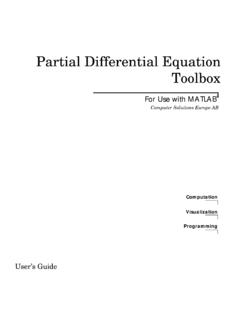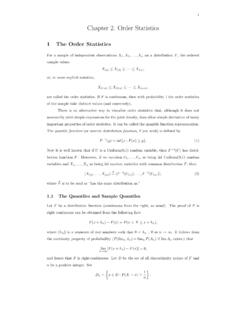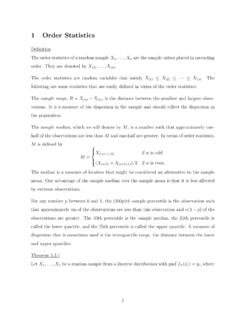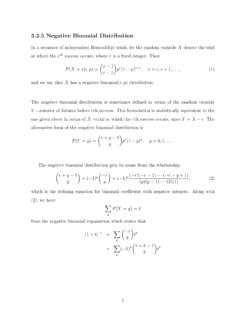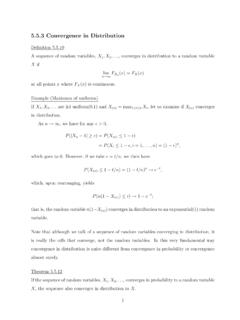Transcription of MATHEMATICAL MODELING AND ORDINARY …
1 MATHEMATICAL MODELINGANDORDINARY differential EQUATIONSI-Liang ChernDepartment of MathematicsNational Taiwan University2007, 2015 January 6, 20162 Contents1 First-Order Single differential is MATHEMATICAL MODELING ? .. and Equilibria .. population dynamics of single species .. to solve single first-order equations .. first-order equation .. of variables .. special classes that are solvable .. Fields and Family of Curves .. Fields .. of curves and Orthogonal trajectories .. *Envelop.. *An example from thermodynamics existence of entropy .. and Uniqueness .. *Numerical Methods: First Order Difference equations .. method .. difference equation.
2 Note ..392 Second Order Linear for linear oscillators .. spring-mass system .. circuit system .. to solve homogeneous equations .. equations (complex case).. equation (real case) .. to solve Inhomogeneous equations .. of underdetermined coefficients .. of Variation of Constants .. oscillators .. oscillators .. and Resonance .. 2linear systems .. and Wronskian .. the fundamental solutions and Phase Portrait ..603 Nonlinear systems in two kinds of physical models .. system .. mechanical system .. systems .. systems .. and linearization .. equilibria .. equilibria in the competition model .. plane analysis .. solutions.
3 System .. der Pol oscillator .. and Homoclinic and orbits ..874 Linear Systems with Constant value problems forn nlinear systems .. Models .. spring-mass systems .. Circuit Systems .. and solution space .. the systems .. systems in three dimensions .. in three dimensions .. the spring-mass systems .. canonical form .. matrix .. of Spectral Theory .. Matrices andexp(tA).. matrices .. (A).. Stability Analysis .. Linear Systems .. 1185 Methods of Laplace transform .. of Laplace transform .. transform for differential equations .. linear equations with constant coefficients .. transform applied to differential equations .
4 Functions and Delta function .. s function .. 1316 Calculus of short story about Calculus of Variations .. from Geometry .. Equation .. from Mechanics .. of Lagrange Multiplier .. hanging rope problem .. inequality .. Brachistochrone .. field model .. 1517 Examples of Nonlinear systems .. on Phase Plane .. of a Hamiltonian system .. Flows .. pendulum .. structure of phase plane .. Pendulum Tautochrone Problem.. Tautochrone problem .. of a cycloidal pendulum .. orbits of planets and stars .. directed force and conservation of angular momentum .. Hamiltonian flows.
5 Theorem .. 1828 General Theory for ODE .. existence .. dependence on initial data .. priori estimate and global existence .. continuity .. (I)is a normed linear space .. (I)is a complete space.. 1949 Stability .. systems .. stability .. function .. e-Bendixson Theorem .. 20610 Numerical Methods for ORDINARY differential Design of numerical schemes .. Truncation error and orders of accuracy .. High-order schemes .. 2162 CONTENTSC hapter 1 First-Order Single What is MATHEMATICAL MODELING ?In science, we explore and understand our real world by observations, collecting data, finding rulesinside or among them, and eventually, we want to explore the truth behind and to apply it to predictthe future.
6 This is how we build up our scientific knowledge. The above rules are usually interms of mathematics. They are called MATHEMATICAL models. One important such models is theordinary differential equations . It describes relations between variables and their derivatives. Suchmodels appear everywhere. For instance, population dynamics in ecology and biology, mechanicsof particles in physics, chemical reaction in chemistry, economics, an example, an important data set is Tycho Brache s planetary motion data collected in 16thcentury. This data set leads Kepler s discovery of his three laws of planetary motion and the birth ofNewton s mechanics and Calculus. The Newton law of motion is in terms of differential , we have many advance tools to collect data and powerful computer tools to analyzethem.
7 It is therefore important to learn the theory of ORDINARY differential equation, an importanttool for MATHEMATICAL MODELING and a basic language of this course, I will mainly focus on, but not limited to, two important classes of mathematicalmodels by ORDINARY differential equations : population dynamics in biology dynamics in classical first one studies behaviors of population of species. It can also be applied to economics,chemical reactions, etc. The second one include many important examples such as harmonic oscil-lators, pendulum, Kepler problems, electric circuits, etc. Basic physical laws such as growth laws,conservation laws, etc. for MODELING will be goal of this lecture is to guide students to learn(i) how to do MATHEMATICAL MODELING ,12 CHAPTER 1.
8 FIRST-ORDER SINGLE differential equations (ii) how to solve the corresponding differential equations ,(iii) how to interpret the solutions, and(iv) how to develop general Relaxation and EquilibriaThe most simplest and important example which can be modeled by ODE is a relaxation system starts from some state and eventual reaches an equilibrium state. Such process is calleda relaxation process. We use the following two examples to explain this relaxation falling objectA object falling down from highty0. Letv(t)be its velocity at timet. Accordingto Newton s law,dvdt= g,( )wheregis the gravitation constant. Usually the object experiences friction. The sign of the frictionforce should be opposite to the acceleration.
9 If we treat the object as a particle, then this frictionshould also depend the speed of the object. The simplest friction model is v. Adding thisfrictional force, the complete model becomesdvdt= g v,( )where is the frictional coefficient, which may depend on other physical parameters, for instance,the surface area of the of an objectAn object is taken out of refrigerator to defrost. Lety(t)be itstemperature at timet. Let the room temperature beKand the initial temperature of the object isy0. To model the cooling/heating process, we first notice that if the object has temperatureK, thenthere is no variation of the object s temperature with the environment. Thus, the rate change ofyisproportional to the difference betweeny(t)andK.
10 The simplest case isdy(t)dt= (y(t) K).( )Here, is a conductivity coefficient. It depends on the object. Sands has larger conductivity thanwater. This model is indeed called Newton s law of you can see that these two models are mathematically identical. We can use one theory tocover them. This will be discussed RELAXATION AND EQUILIBRIA3 Methods and tools to solve the relaxation equationLet us solve the ODE by Calculus as thefollows. The technique is calledseparation of variables. In this technique, The terms with samevariable are moved to the same side. After that, we can integrate both sides. See the (y K).dyy K= dtWe integrate both sides to getlog|y K|= t+ ,Cis an integration constant.

